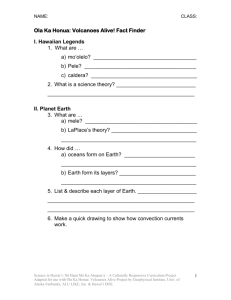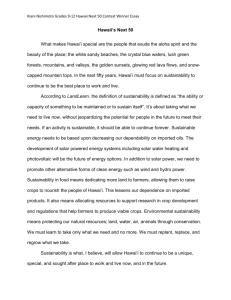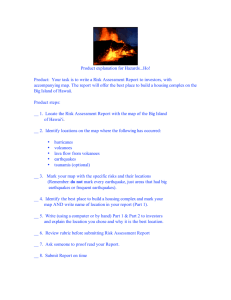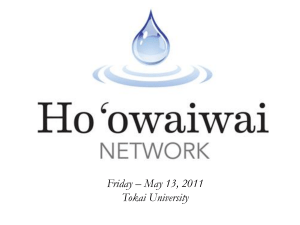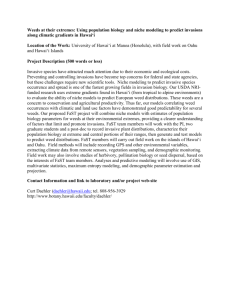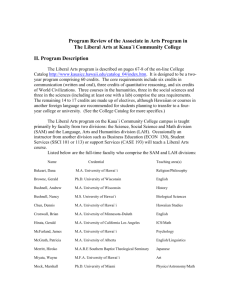I
advertisement
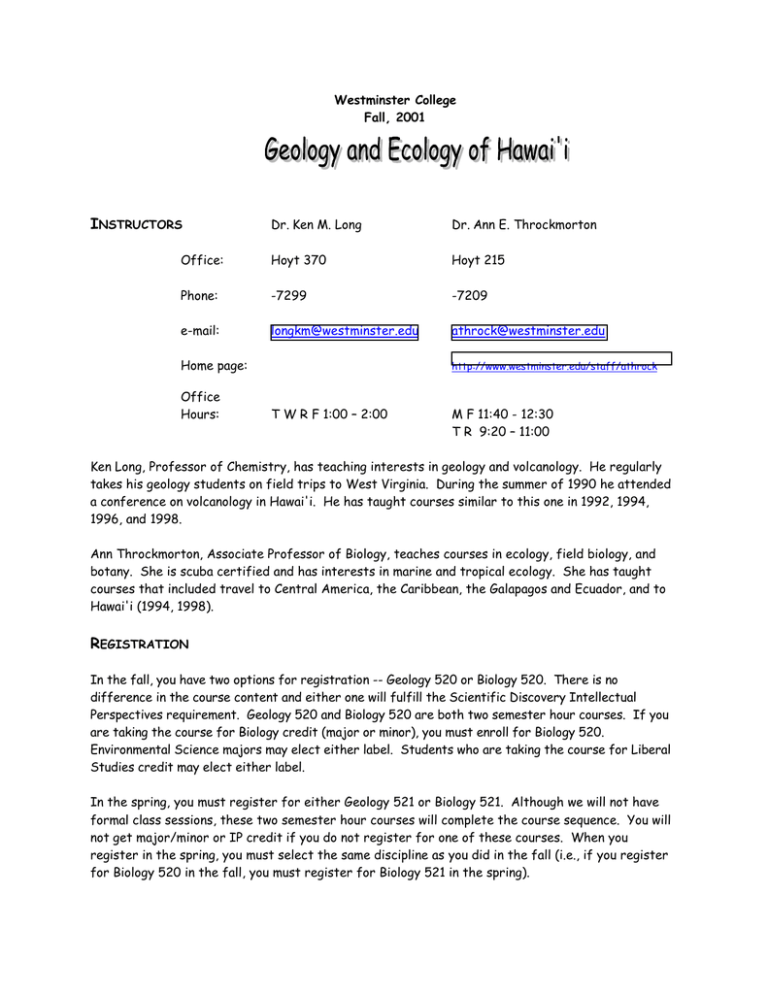
Westminster College Fall, 2001 INSTRUCTORS Dr. Ken M. Long Dr. Ann E. Throckmorton Office: Hoyt 370 Hoyt 215 Phone: -7299 -7209 e-mail: longkm@westminster.edu athrock@westminster.edu Home page: Office Hours: http://www.westminster.edu/staff/athrock T W R F 1:00 – 2:00 M F 11:40 - 12:30 T R 9:20 – 11:00 Ken Long, Professor of Chemistry, has teaching interests in geology and volcanology. He regularly takes his geology students on field trips to West Virginia. During the summer of 1990 he attended a conference on volcanology in Hawai'i. He has taught courses similar to this one in 1992, 1994, 1996, and 1998. Ann Throckmorton, Associate Professor of Biology, teaches courses in ecology, field biology, and botany. She is scuba certified and has interests in marine and tropical ecology. She has taught courses that included travel to Central America, the Caribbean, the Galapagos and Ecuador, and to Hawai'i (1994, 1998). REGISTRATION In the fall, you have two options for registration -- Geology 520 or Biology 520. There is no difference in the course content and either one will fulfill the Scientific Discovery Intellectual Perspectives requirement. Geology 520 and Biology 520 are both two semester hour courses. If you are taking the course for Biology credit (major or minor), you must enroll for Biology 520. Environmental Science majors may elect either label. Students who are taking the course for Liberal Studies credit may elect either label. In the spring, you must register for either Geology 521 or Biology 521. Although we will not have formal class sessions, these two semester hour courses will complete the course sequence. You will not get major/minor or IP credit if you do not register for one of these courses. When you register in the spring, you must select the same discipline as you did in the fall (i.e., if you register for Biology 520 in the fall, you must register for Biology 521 in the spring). CLASSROOM INSTRUCTION Wednesday, 6:30 - 9:00 p.m. Hoyt 152 In classroom sessions, you will be introduced to the basic principles of geology and ecology and become acquainted with many of the natural and cultural phenomena that we will observe in Hawai'i during the travel portion of the course. You will study the geological development of the islands, the biota of the near-shore and terrestrial environments, principles of tropical island ecology, and some of the cultural and historical background of the Hawai'ian Islands. TEXTBOOK Hawaii: The Ecotravellers’ Wildlife Guide, by Les Beletsky, Academic Press, 2000. ISBN 0-12-084813-9 TRAVEL January 2 to January 17, 2002 During this time, we will travel to four of the largest of the Hawai'ian Islands, which Mark Twain declared to be "the loveliest fleet of islands that lies anchored in any ocean." We will visit unique locations and observe some of the best examples of Hawai’ian geology, ecology, culture, and history. HAWAI'I -- the Big Island. Hawai'i is both the name of the state and of this island which is almost twice as large as all of the other Hawai'ian islands combined. The youngest of the islands, it is the site of five volcanoes, two of which are still active. On the east side of the island, near Hilo, are tropical rain forests, while on the south side is the Ka'u Desert. We will spend four days on the Big Island. There, we will we will explore Volcanoes National Park and hike through Kilauea Iki, a dormant volcano, and view the most recent lava flows. We will paddle kayaks to sea caves, visit an ancient place of refuge, snorkel in Honaunau Bay coral gardens where sea turtles feed, and join a local family for a Hawai’ian luau. MAUI -- the Valley Island. Second largest island, formed by two extinct volcanoes that joined together. The most prominent feature on the island is Haleakala crater, covering 25 square miles. Every year, hundreds of humpback whales calve in the water near the island. Kahului and Lahaina are the largest cities. Maui will be our home for five days as we hike through Haleakala Crater, drive the curvaceous Hana Highway, trek to Waimoku Falls and Hamoa Beach, and view humpback whales. KAUA'I -- the Garden Island. Looks like a circle with Kawaikini Peak in the center. Nearby is Mount Waialeale, the world's rainiest spot with an average annual rainfall of 460 inches. The oldest island, Kaua'i is dissected by many canyons; the largest one is Waimea with colorful rock walls up to 3,000 feet high. The Na Pali Coast is famous for its stunning vistas. Kauai is home to many rare and interesting birds. We will spend four days on Kauai, hiking the Na Pali coast and the Awaapuhi Ridge Trail, viewing Waimea Canyon, "the Grand Canyon of the Pacific," and visiting the Kilauea National Wildlife Refuge. O'AHU -- the Gathering Place. Third largest of the islands, about 40 miles by 26 miles, home of 80% of the State's people. It is well-known as the location of Honolulu (the state capitol), Waikiki Beach, Pearl Harbor, Diamond Head, and the North Shore surfing community. The island was formed by two volcanic mountain ranges, the Ko'olau on the windward coast and the Wai'anae Range on the lee coast. We will spend three days on this island, visiting Pearl Harbor, the Bishop Museum, the Waikiki Aquarium, and Oahu's pineapple and sugar plantations. METHODS OF INSTRUCTION 1. Lectures and discussion: This will follow the tentative schedule included below. We expect you to attend class, pay attention, and participate actively in the discussion by answering questions, asking questions, and making appropriate comments. You should read the assigned readings ahead of time. 2. Readings and assignments: In addition to assigned readings from the textbook, we will put books or journal and newspaper articles on reserve in Mack library. Information from Web sites may also be assigned. These readings will augment the lecture and provide material for discussion. In addition, you will given assignments that will enhance particular lecture topics and cover additional topics. 3. Final exam: There will be one exam covering material from lecture, reading assignments, and videos. Questions will be both objective and essay. 3. Final essay: After we return from the islands, you will write a final essay that will address specific questions and integrate your knowledge regarding the geology, ecology, and culture of Hawai'i. It will also include your observations and opinions. 4. Journal: Each student must keep a journal during the field portion of the course. This is for your personal and scientific observations, reflections, and notes. Although your journal will be private, the instructors will skim it after we return from Hawai’i to determine that you made complete, regular entries and pertinent observations. 5. Instructors' evaluation: In this subjective part of the grade, we will evaluate you on your performance in class and during the travel portion of the course. In the classroom, this will include attendance and your participation during lecture and discussion. While we are in Hawai’i you will be graded on your participation in group activities (discussions, demonstrations, hikes, museum visits, etc.) and on your contribution to group work. 6. Self evaluation: After we return from the islands, you will be asked to reflect on your own performance in the course – what you did well, what you could have done better, and how much you learned in the course. Based on this, you will give yourself a letter grade and write a justification of the grade. 7. Oral report: While we are in Hawai’i, everyone in the class will present a short report on a topic related to the geology or ecology of Hawai’i. Reports will be about ten minutes long. Before the trip, you should make up a short handout to present to the class and make photocopies for everyone in the class. You will receive more information about what the presentation and the handout should include, as well as a possible list of topics. 8. Organism list: While we are in Hawai’i, you will keep a list of the plants and animals that you see. Most people include in the daily entries in their journal or put it in a special section in the back. We will have trail guides and other books along with us to help with this. You will be graded not only on how many organisms you list, but also on completeness (i.e., did you pay attention to plants as well as animals, did you observe the most important organisms in the habitats that we visited). The final essay, journal, organism list, and self evaluation will be due by 5:00 p.m. on Monday, February 11, 2002. GRADING Your grade for Bio/Gel 520 will be based on your performance in three areas, weighted as follows: Final exam = 60% of final grade Assignments = 30% of final grade Class participation = 10% of final grade Your grade for Bio/Gel 521 will be based on your performance in six areas, weighted as follows: Final essay = 40% of final grade Journal = 20% of final grade Instructors' evaluation = 10% of final grade Self evaluation = 10% of final grade Oral report = 10% of final grade Organism list = 10% of final grade Your final grade in both courses will be based on the following scale: Above 93%: A 87% - 90%: B+ 77% - 80%: C+ 67% - 70%: D+ 90% - 93%: A- 83% - 87%: B 73% - 77%: C 63% - 77%: D 80% - 83%: B- 70% - 73%: C- 60% - 73%: DBelow 60%: F CLASS SCHEDULE Lecture will follow the tentative schedule below. You will receive reading assignments at least one week prior to the date on which they are to be discussed. DATE TOPIC August 29 Overview of the class Overview of Earth Introduction to Ecology; what are the tropics? September 5 Volcanoes September 12 Earthquakes Introduction to island ecology; abiotic factors September 19 Plate tectonics Ecosystems of Hawai’i; diversity, endemism, and rarity September 26 Dispersal to islands; succession October 3 Weathering, erosion, and soil Development of insular biotas; extinction October 10 Mass movement and mass wasting Evolution on islands October 17 Underground water; streams and their work October 24 Coastal zones and processes Introduction to rainforests and reefs October 31 Rainforests November 7 Reefs November 14 Survey of the geology of the Hawai'ian Islands Terrestrial ecosystems of Hawai’i November 28 Human prehistory of the islands December 5 Human impact on Hawai'ian ecology December 12 Final Exam 6:30 p.m., Hoyt 152
